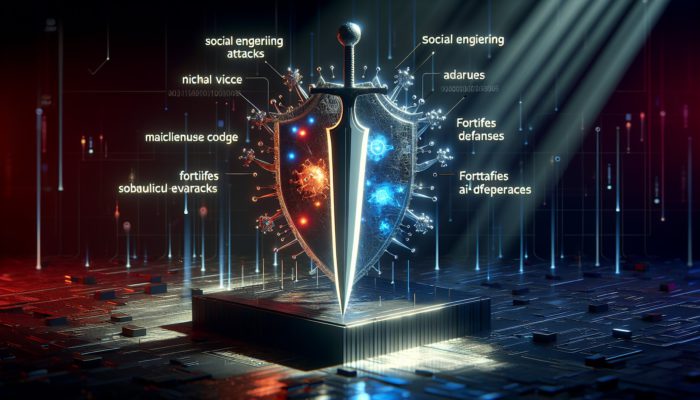Uncover the CISO Experience: Master Your Cybersecurity Environment Today
Engage with Cybersecurity Insights: Welcome to the second episode of Series 3 of the CISO Experience, which streams live on the Infosec Live channel. This compelling series dives deep into genuine discussions with leading security experts, focusing on the technological advancements, human factors, challenges, and fresh opportunities that are reshaping the cybersecurity landscape. Our sponsor, Simple Security, firmly believes that cybersecurity does not have to be overly complex. They are dedicated to delivering enterprise-level security solutions that are accessible, affordable, and effective for businesses of all sizes and sectors.
Learn About Adam Pilton's Inspirational Transition from Law Enforcement to Cybersecurity Expert

Today, we are thrilled to welcome Adam Pilton, an enthusiastic cybersecurity professional whose career began in 2016. Adam's journey is both motivating and educational, initially starting in the domain of cybercrime investigation and later transitioning into advisory roles. His distinctive viewpoint combines technical knowledge with practical application, enabling him to simplify intricate risks into actionable strategies for business executives, thereby enhancing their understanding of cybersecurity protocols and best practices.
Key Takeaways from Adam's Early Career in Law Enforcement
Adam began his professional journey as a police officer, dedicating 15 pivotal years to this position. He led the covert operations unit, which comprised three specialized teams: the Covert Authorities Bureau, Communications Data Investigators, and the Cybercrime Team. His responsibilities included securing lawful authorities for covert operations while addressing challenges in both physical and digital environments. This comprehensive experience equipped him with a deep understanding of both the operational and technical aspects of law enforcement.
One of the most profound insights Adam gained from his early experiences was the significant human impact of cyber threats. He interacted with victims, both individuals and businesses, witnessing firsthand the devastating effects of cybercrime. For instance, losing access to a Facebook account may seem trivial at first; however, if it contains irreplaceable memories like photographs of loved ones, the emotional impact can be catastrophic and enduring. This realization shapes Adam's approach to cybersecurity, emphasizing empathy and understanding in his work.
Strategic Career Shift: Adam's Move to the Private Sector
After 15 rewarding years in law enforcement, Adam realized he had reached the pinnacle of his career. The limited opportunities for expanding his team's digital capabilities, combined with the appealing nature of frontline roles, prompted him to decide to leave the police service. He subsequently joined Heimdal Security, drawn by their high-quality products and the opportunity to continue his impactful work in the field of cybersecurity. This transition marks a pivotal moment in his career, allowing him to leverage his extensive experience in a new and challenging environment.
Recognize Cybersecurity Challenges and Motivations for Taking Proactive Actions

Adam highlights that the cybersecurity industry is facing a significant motivation dilemma. Despite constant media coverage highlighting various cyber threats, many organisations acknowledge the urgent need for action yet struggle to implement effective solutions. The overwhelming complexity associated with cybersecurity often leaves businesses uncertain about where to begin their improvement efforts. This confusion can lead to inaction, further exacerbating their vulnerability to cyber threats.
To address this issue, Adam advocates for the adoption of structured frameworks like Cyber Essentials in the UK. These frameworks provide a clear roadmap for organisations to enhance their cybersecurity measures, enabling them to implement fundamental practices while progressively building their capabilities. A recent study indicated that 60% of individuals who complete the Cyber Essentials programme gain new insights with each attempt, underscoring the importance of ongoing education and development in this rapidly evolving field. By embracing such frameworks, businesses can cultivate a proactive cybersecurity culture.
The Crucial Role of Law Enforcement and Government Support in Cybersecurity
Adam acknowledges that law enforcement agencies and government organisations play a crucial role in assisting businesses with their cybersecurity needs. However, he also points out the necessity for the industry to improve its approach to providing support. The outdated strategies of fear, uncertainty, and doubt used to market cybersecurity solutions have lost their effectiveness; businesses now require more practical, actionable guidance and support. This shift towards a more constructive approach can foster collaborative efforts that enhance overall cybersecurity resilience.
Identify and Understand Emerging Threats and Key Trends in Cybercrime
The landscape of cyber threats has significantly evolved over the past decade, with attackers often staying several steps ahead of organisations. A notable trend is the resurgence of social engineering attacks, exemplified by groups such as Scattered Spider. These sophisticated attacks frequently target IT help desks, employing advanced techniques that are often bolstered by <a href="https://limitsofstrategy.com/artificial-intelligence-ai-when-a-real-human-is-needed/">artificial intelligence</a>. This evolution in tactics highlights the necessity for businesses to stay vigilant and informed about the latest threat vectors.
Adam further emphasizes the shift in cybercrime dynamics, moving from individual hackers to highly organised crime syndicates. These groups operate with the structure of legitimate businesses, complete with dedicated customer service teams. For instance, platforms offering ransomware-as-a-service now provide legal assistance to facilitate ransom negotiations, illustrating the alarming sophistication and professionalism of modern cybercrime. This professionalization of cybercrime necessitates a robust response from security professionals and organizations alike.
Leveraging AI's Dual Role to Fortify Cybersecurity Defenses

Artificial intelligence serves as a double-edged sword in the realm of cybersecurity. While it has the potential to enhance the efficacy of social engineering attacks, it also offers valuable opportunities for defense and fortification. Adam believes that AI will play a pivotal role in enabling businesses to create more secure environments; however, it will also introduce new challenges that must be proactively managed. This duality requires organizations to remain proactive in their approach to integrating AI into their cybersecurity strategies.
Creating a Security-Conscious Culture within Your Organization
Building a culture of security awareness is essential for a robust cybersecurity strategy. Adam underscores the importance of integrating security principles into the very fabric of an organisation's culture, beginning with the formulation of clear mission and vision statements. This comprehensive approach ensures that every employee understands their vital role in maintaining security within the organisation. By fostering a culture of security, organizations can significantly reduce their vulnerability to cyber threats.
To effectively engage employees, Adam recommends making training relevant to their everyday lives. For example, illustrating the impact of losing personal data, such as cherished photographs, on a social media platform can significantly deepen their understanding of the importance of cybersecurity in a practical and meaningful way. This connection to personal experiences reinforces the necessity of vigilance in maintaining cybersecurity practices.
Implementing Frameworks for Cybersecurity Maturity and Ongoing Development
For organisations embarking on their cybersecurity journey, Adam strongly endorses the implementation of structured frameworks such as Cyber Essentials. These frameworks offer a clear, systematic method for establishing security measures, thereby helping businesses avoid feelings of being overwhelmed while building a resilient foundation. By employing these frameworks, organizations can focus on essential practices that will yield tangible improvements in their security posture.
He also emphasises the critical importance of continuous improvement, as cybersecurity is an ongoing process rather than a one-off project. Organisations must regularly adapt and evolve their security posture to meet the ever-changing threat landscape and the dynamic contexts in which they operate. This commitment to continuous enhancement is vital for sustaining effective cybersecurity measures.
Anticipating the Future of Cybersecurity: Opportunities and Challenges Await
Adam expresses optimism regarding the heightened public awareness of cybersecurity. As younger generations become more acquainted with technology, they bring a deeper understanding of cybersecurity principles into their workplaces. This shift in awareness holds the potential to significantly assist businesses in cultivating more resilient security cultures. By harnessing this growing awareness, organizations can better prepare for the challenges that lie ahead.
Moreover, Adam identifies promising opportunities in artificial intelligence that could empower businesses to automate and enhance their security measures. However, he cautions that the rise of AI also presents new challenges that organisations must be prepared to confront. This balance of opportunity and challenge underscores the need for proactive strategies to incorporate AI in a way that strengthens cybersecurity defenses.
Empowering Future Generations through Comprehensive Cybersecurity Education
Adam asserts that there must be greater emphasis on educating children about cybersecurity principles. While educational institutions currently employ a variety of approaches to teaching these concepts, a more standardised curriculum could better equip the next generation for the complexities of the digital world. By establishing a solid foundation in cybersecurity education, we can prepare children to navigate the challenges of an increasingly digital landscape.
Additionally, parents hold a vital responsibility to educate their children about online safety. Adam recommends establishing clear boundaries regarding device usage and teaching children about the risks associated with sharing personal information online. This guidance is crucial in fostering a generation that is both informed and vigilant about cybersecurity threats.
Valuable Insights Gained from Adam Pilton's Journey: Overcoming Cybersecurity Challenges
Adam Pilton's remarkable journey from police officer to cybersecurity professional offers invaluable insights into the significant human impact of cyber threats and the urgent need for pragmatic, actionable security measures. As businesses navigate the intricate world of cybersecurity, structured frameworks such as Cyber Essentials can provide a solid foundation for developing a resilient security posture. By learning from Adam's experiences, organizations can better understand the importance of addressing cybersecurity challenges head-on.
The future of cybersecurity is filled with promise, marked by increased awareness and the transformative potential of AI to enhance security measures. However, this evolving landscape also introduces new challenges that businesses must proactively address. By prioritising security awareness, fostering an inclusive culture, and committing to continuous improvement, organisations can effectively stay ahead of emerging threats and safeguard their most valuable assets.
The post Cybersecurity Insights: From Police to CISO appeared first on Ezi Gold.
The Article Cybersecurity Insights: Transitioning from Police to CISO Was Found On https://limitsofstrategy.com
The Article Cybersecurity Insights: From Police Force to CISO Role First Appeared ON
: https://ad4sc.com

